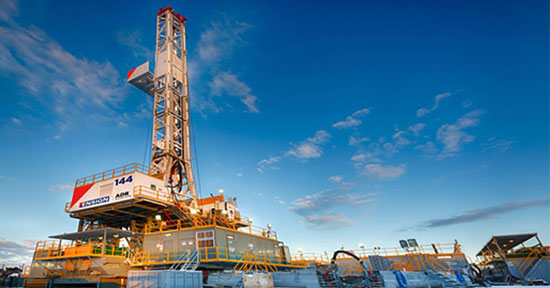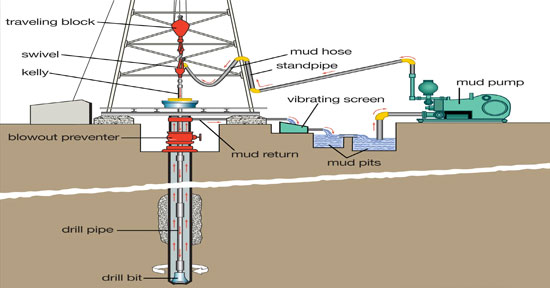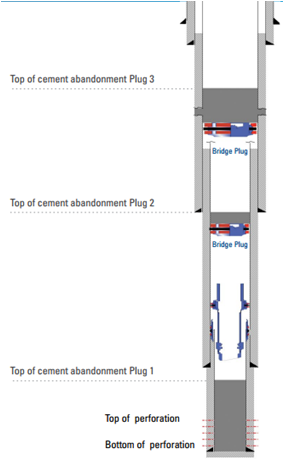Design of oil wells
The term “drilling” of oil wells indicates the whole set of actions necessary for the construction of circular section wells, applying the erosion techniques. To create such a well it is necessary to perform the following actions simultaneously (the process of corrosion or drilling):
- Overcoming the resistance of the rock, breaking it into small particles with dimensions only a few mm.
- Removal of rock particles, still acting on fresh material.
- Maintaining the stability of the walls of the excavated area.
- Prevent the entry of fluids (containing perforated formations) into the well.


This is made possible by the use of rotary drilling rigs which operate today in the field of hydrocarbon exploration and production. “Drilling rig” is a complex of mobile vehicles that can be moved (on land and at sea) from one drilling site to another, creating a series of wells. During rotary drilling, the rock is dismantled using a cutting tool which rotates and at the same time pushes against it to the end of the excavated area by a series of drills, consisting of hollow steel pipes of circular section (screwed together) .
Analyzing and processing all accessible information provides the relevant engineers with the essential elements for designing a corrosion (drilling) program. This data is available from existing documents, such as: “Geological profiles; Wells Registers; Pressure ratios; Corrosion (drilling) ratios; Fluid ratios during corrosion (drilling); Cementation reports; ” and others like these. Each well has its own specific features, such as: depth can vary, it can be research, development or evaluation well, located on land or at sea, vertical or horizontal. However the basic criteria are the same for all types of wells. The first step to be taken by engineers in designing the corrosion or drilling program is to construct the inclination that the pressure gradient curves have according to depth (geostatic gradients, pore pressure and their fracture), to then design well framing profile.
Platform selection, wellhead and BOP
The framing levels, the diameters and weights of the strings, the respective pressures and temperatures, as well as the volumes of mud to be worked on, are all aspects involved in determining the type of equipment, the choice of inflation prevention systems (BOP, collector of choke, hydraulic circuit) and wellhead adjustment. The choice of device is closely related to the depth to be achieved and to the weight of the strings in question. Referring to the weights of the strings to be used, work with devices that have different characteristics, and what is of fundamental importance is the strength of the whole mechanism (travel block, crown block, hook and cord floor) on which the string depends while positioned in the well.
When this activity is performed at sea, the choice of platform is determined not only by the weight of the strings, but also by the depth of water in the area of operation. “Drilling equipment” installed on ships or offshore platforms are built to reach the maximum possible depth and have all the necessary material and tools for drilling on board. The composition of the wellhead depends on the pressures that can be achieved during the various stages of the work – both during drilling and during production – but also on the diameters of the strings that will be lowered into the well.

Control of drilling (corrosion) operations
The complexity of the drilling process, its high costs, the need to guarantee the full efficiency of the equipment, as well as the observance of safety and environment require continuous optimization of operations. This optimization can be achieved through monitoring and processing of all available data, both geological and drilling. To achieve the aforementioned objectives, any drilling rig, and especially those that have to drill complex, deep and consequently costly wells, are equipped with sophisticated units for mud cutting. These units, through proper sensors and the activity of specialized personnel, allow the acquisition, processing and interpretation of a wide range of information in the interest of both the geologist and the drilling engineer.
Mud cutting units are equipped not only with sensors positioned in the right parts of the device, which allow automatic, continuous retrieval of the most important parameters, but also with advanced information systems. It is also worth mentioning expert systems, as tools for managing real-time operations, with the aim of reducing time and costs. The sensors transmit signals to a computerized system located in the mud cutting booth. In these booths it is foreseen the presentation of the selected data for the operational centers in graphical form, their storage in certain data banks and their distribution through radio, dedicated telephone lines and satellite communications.
Drilling costs
The drilling program also envisages the budget needed to achieve the objectives related to the construction of the well. The costs of drilling a well can vary depending on the particular type of well planned and the environment in which it will be worked. The budget included in the drilling program indicates the amount of economic resources available, which should be respected as much as possible. But, it is understandable that the real amount depends on the problems that appear during drilling and on the capacity of the engineers to deal with them in time without compromising the achievement of objectives.
Well Abandonment
After the completion of the corrosion (drilling) process, if the well is productive in terms of hydrocarbons, then continue to work on all those operations that will ensure the establishment of its economic activity. Conversely, if the well turns out to be barren or economically unusable it will be closed.
The process of closing the well involves restoring the initial conditions of the unframed well section and possibly also the framed part, if the separation of permeable levels of different pressures is not ensured. The purpose of these measures is to prevent the passage of fluids from one level to another.
The final closure of a well must not only meet the requirements set out in the best engineering practices set by the operator, but must also meet all the requirements of the law aimed at protecting the environment and safety of people living in the vicinity of the well. abandoned wells.

